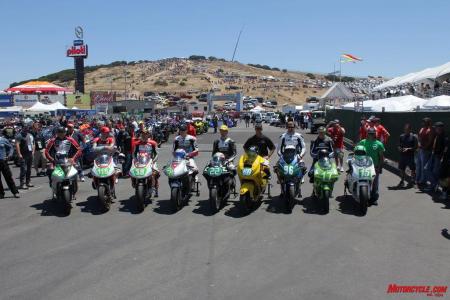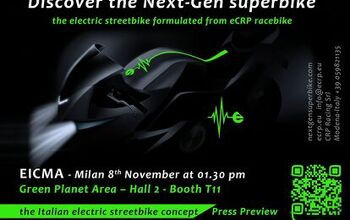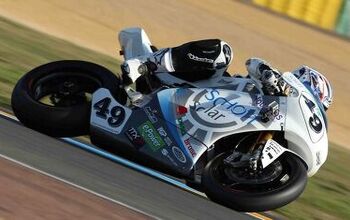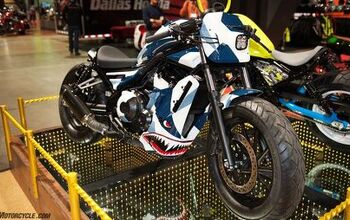Electric Motorcycle Racing Season Wrap-Up
Sniff at electrics if you want. But the best of them became really fast while you weren’t looking.
At the Mazda Raceway Laguna Seca round in July, Steve Rapp qualified his Mission R with a lap of 1:31.376, just 10 seconds off the time of MotoGP pole-sitter Jorge Lorenzo. Could you, riding your bike, get within 10 seconds of Lorenzo and his Yamaha?
Even informed enthusiasts don’t necessarily recognize the names of the players in electric motorcycle road racing: Brammo, Lightning, Mission, MotoCzysz, Moto Electra, Protomoto, Volt.
But count on these and other names in this intriguing pursuit to become much better known. The time is right for higher-efficiency, non-fossil-fuel, zero-carbon motorsports, with organizers at all levels sensitive to accusations of burning up fuel running around in circles for fun.
Motorcycle racing has to take this issue seriously, and electric road racers represent the sharp end of that awareness. Under the auspices of TTXGP, three international championship series ran in 2011, in North America, Europe and Australia. Technology partners lined up for both promotional purposes and to make the necessary hardware available to competitors. From that perspective, it appears electric racing may be approaching critical mass.
Of course, it’s easy to scoff. The fields were thin this year, the racing was rarely close, the bikes themselves are boringly noiseless, and mechanical reliability a mere hope.
But note: these things are not slow.
Rapp’s qualifying time at Laguna would have placed Rapp mid-field (20th) on the Daytona Sportbike grid that weekend. And in the TTXGP race (which he won by 40 seconds), Rapp’s fastest lap of 1:33.194 was only 8.5 seconds off the fast lap Pro Superbike winner Tommy Hayden wrung out of his Yoshimura GSX-R1000.
For more than a century, racing of motorcycles (and automobiles) has served two critical purposes (three if you count letting young studs get their competitive rocks off). 1) Racing is show business, for the entertainment of paying spectators. And 2) racing is the great motivator for advancing technology, pushing development farther and faster than anything short of war, which is sort of the same thing.
How has road racing of electric motorcycles done on those scores? The best grade it can get for spectator appeal is Needs Improvement. But it gets a Passed with Honors for driving technical innovation.
In 2011, the North American TTXGP season consisted of three events run in conjunction with AMA pro races, at Infineon Raceway in Sonoma, CA, Mazda Raceway Laguna Seca in Monterey, CA, and Miller Motorsports Park in Tooele, UT.
All the races, frankly, were terminally boring for spectators, partly because electric racers are too nearly silent, like watching racing on “mute.” Idle chatter among fans in the stands does not stop when the field streams by, the way it naturally does when internal-combustion engines with light muffling and open throttles scream past.
The lean fields didn’t help. Only four riders were on track at Infineon and six at the season-closing race at Miller. Laguna was better, with 12 entries making the event (including a few from overseas), spurred on by the presence of the MotoGP circus. But these are early days and participation will surely grow.
With that growth will come increasing commonality of hardware, as everyone discovers what works, and that will help tighten up the racing. As long as everyone is trying their own solutions – and investment levels vary dramatically across the electric paddock – lap times are going to be all over the map and the racing will rarely be wheel-to-wheel.
So the show-business factor isn’t even close yet. But the drive to innovate technically is real and tangible. The teams in the electric paddock show all the fire, ingenuity and resourcefulness that racing demands. They are pioneering a new and untested technology, making use of components and systems that were never intended for a racing motorcycle.
For these guys, prepping for the race isn’t just a matter of finding the right chassis setup. It’s figuring out if the chassis they built from scratch can be made to work at all. And whether the battery pack will take enough charge to finish the race. And if they’ve fixed the overheating controller that keeps pulling back on the current. And just what the hell was it that caused the motor to lock up?
It’s all uncharted territory for the electric racer, and that means almost every step forward takes an original solution. Yes, a knowledge base is building, some ready-to-order electric setups are starting to reach the market, batteries are getting smaller and lighter, and existing motorcycle-chassis orthodoxy can provide a starting point. But still, there are new and puzzling challenges at every turn, and the crucible of competition fires everyone to push hard against the technology barrier. That’s how progress is made.
So give these boys credit for taking the green flag at all. Some look like they should be collecting spare change in a hat out in front of their EZ-Up, but they are all serious about doing the very best they can, and that’s the point.
Here’s a rundown on the teams that participated in the TTXGP North American Championship in 2011.
Brammo Racing
This may be the lone “factory” team in the electric paddock, since Brammo currently sells electric motorcycles in various specs to consumers for road use. Internet entrepreneur Craig Bramscher launched Brammo, Inc., which offers production Enertia and Engage electric motorcycles, plus the overdue high-performance Empulse. The race team’s Empulse RR is considered a “production-intent prototype,” driving the development of systems and designs. The company offers its Brammo Power battery pack, management and drive systems to other manufacturers, and recently inked a deal to provide race-ready Empulse TTX motorcycles to other e-competitors for the 2013 season.
The Brammo Empulse RR is built on an aluminum twin-spar frame of the company’s own design, and uses the 12.4 Kw/h lithium battery pack as a stressed member.
The team finished third in the inaugural Isle of Man electric race back in 2009. They sat out 2010 but came back to win the 2011 TTXGP North American Championship. With racer/scribe Steve Atlas aboard, Brammo was easily “best of the rest” behind MotoCzycz, Lightning and Mission, and since those three missed Infineon and split the results at Laguna Seca and Miller, Brammo took the series crown on points.
Director of product development Brian Wismann says the bike’s strength is the balance it strikes between weight (470 pounds) and power. He also says they are looking to reduce chassis rigidity in some places and introduce some controlled flex, an indication they are well along in development.
Lightning Motorcycles
Silicon Valley entrepreneur Richard Hatfield and his dedicated band of engineers at Lightning Motorcycles have had a checkered 12 months. Back in 2010, the Lightning Superbike won the TTXGP North American championship, using its steel-trellis frame, A123 battery pack and motor derived from a General Motors EV-1 car unit. But the team did not show for the Infineon opener in 2011 and had to start from the back of the grid for missing qualifying at Laguna Seca. Still, Michael Barnes stormed through the Laguna field and took a strong third behind MotoCzycz and Mission, and rider Tim Hunt got second at Miller.
Along the way, the team upgraded to a new Remy HVH250 motor and Ener1 lithium-ion batteries, and proved the package’s potential by setting a new electric motorcycle land-speed record of 215.960 mph at the Bonneville salt flats. Paul Thede of Race Tech was at the controls for the record runs, and is also on board for chassis and suspension development.
Hatfield and Lightning have great ambitions for advancing electric technology and commercializing it, and they will be one to watch.
Mission Motors
If there were points for sheer beauty in the electric race paddock, the Mission R would clean up. San Francisco-based Mission Motors had James Parker design the frame and Tim Prentice the bodywork, and the bike is a stunner. Compact with flowing lines, the package is smaller than a 600 supersport and uses its motor as a fully stressed member. The 14.4 kWh battery pack is semi-stressed and quickly swappable.
Mission only showed up for one event in 2011, the Laguna Seca round, but, boy, did they show up for that one. With ace racer Steve Rapp holding the throttle, the Mission R completely dominated the weekend, posting fast time in practice, taking pole in qualifying, setting fast lap in the race and winning convincingly. “It’s an easy bike to ride,” said Rapp, “and a lot of fun. These are serious bikes and they are very fast.”
Indeed. Rapp and the Mission R circulated Mazda Raceway Laguna Seca in 1:31.3, a pace which would’ve qualified him fifth on the AMA Supersport class grid and was nearly 14 seconds quicker than the best e-bike lap in 2010. That’s how quickly this technology is progressing.
MotoCzycz
Many of us first became aware of Portland, OR, architect and fourth-generation motorcycle rider/racer Michael Czycz six years ago when he unveiled a wildly radical proof-of-concept racebike, the C1 990. Today, his focus is on developing competitive electric-powered road racers.
And he’s enjoying good success at it. His team, now with major sponsorship from Segway, took first and second at this summer’s Isle of Man TT Zero event, and came to Laguna Seca for the TTXGP race as defending champion. There was no matching Steve Rapp and Mission that weekend, but a strong second place convinced Czycz that the bike was there – and he should replace himself in the saddle with a pro racer more concerned with winning than with not pranging an expensive prototype.
The logic was sound, and in the last race at Miller, local ace Shane Turpin rode the bike to a clear victory. Team Segway MotoCzycz campaigned a 2011 version of the E1pc racer, now with an updated Remy motor and Dow Kokam batteries carried inside the sleek fairing instead of running down the flanks like an exoskeleton. Czycz has always been enamored of unconventional solutions, but these results show he is also managing to develop his designs to practical success.
Moto Electra
Not many race teams can claim to be based on a sheep farm in Highland County, VA, but Brian Richardson likes the distinction. His small Moto Electra team also has a distinctive race bike, built around a classic Norton theme. The frame is a ‘60s Featherbed replica from Framecrafters – remember twin rear shocks? – with bodywork styled after the John Player racers of the ‘70s.
Sadly, the lovely fiberglass suffered when a mysterious motor lockup low-sided rider Thad Wolff in Friday practice at the Infineon opener. The team got the bike on track as a naked streetfighter for that weekend’s racing, and Wolff actually found he preferred the added leverage from spreading out the clip-ons. At Laguna, the team used a simple number plate and flyscreen arrangement, but had the full JPN fairing back in place for Miller.
Moto Electra ran strong and consistent in all three events, generally finishing right behind Brammo. Their persistence was good enough for second place in the final points standings.
Protomoto
Ely Schless is an electrical engineering consultant, machine shop owner and long-time road racer. So he took a seemingly obvious though uncommon approach to building an electric race bike. He started with a proven road racer, a Honda RS250, and converted it to electric power, leaving as much as he could of Honda’s development work intact. He squeezed a 7.5 Kw/H battery pack and motor (a two-year-old unit from his Ashland, OR neighbors, Brammo) into the RS’s compact twin-spar frame. The bodywork is essentially unmodified. It’s easy to walk by the Protomoto racer and not notice it’s an electric.
With an all-up weight of just 320 pounds, the little RS-based Protomoto entry should offer good all-around performance. Unfortunately, Schless struggled with component overheating and other technical challenges and never showed consistent speed. Still, as the only competitor in the lower-battery-capacity TTX75 class to get to all three events, and score first- or second-place points in every race entered, Protomoto won a victory of its own.
Volt Motorcycles
Four years ago, well before there was any place to race an electric motorcycle, Kenyon Kluge began playing with the concept. Today he is the rider for Volt Motorcycles. The small team, directed by Eland Eggars, includes a number of Zero Motorcycles employees (unofficially), and key sponsorship from Thunderstuck, which provided the 7.5 Kw/H AC 20 motor kit.
The bike uses a surprisingly intact Yamaha R1 chassis. In choosing to run TTXGP’s lightweight “75” class, and thus going to a 7.5 Kw/H lithium-polymer battery pack, the team shed all of 100 pounds from the bike’s 2010 race weight. Kluge piloted the Volt racer to comfortable third-overall and first-in-class finishes in both races at Infineon, but DNFed at Monterey and did not make the trip to Miller.
Final Thoughts
Every one of these teams, and doubtless others forming right now, are pioneering a concept and a technology that we have to consider exciting, even if the contests themselves haven’t been. Many of these groups are looking to market their developments to motorcycle and automobile manufacturers with an interest in electric propulsion. There is a lot brewing here.
We are rooting for TTXGP and electric motorcycle racing to find its momentum. Motorsports needs this kind of innovation. And the guys taking the lead deserve our attention and respect.
Related Reading
Himmelmann Dominates FIM e-Power & TTXGP Combined Event
Movie Review: Charge
First U.S. TTXGP at Infineon Raceway
2011 Red Bull U.S. Grand Prix Event Report [Video]
2011 TTXGP / e-Power Laguna Seca Results
2011 Isle of Man TT Recap
2013 Brammo Empulse TTX Race Bike Announced
2010 FIM e-Power race at Laguna Seca
2011 Brammo Empulse Preview
Roehr launches electric sportbikes
All Things Electric on Motorcycle.com
More by Kevin Smith







































Comments
Join the conversation